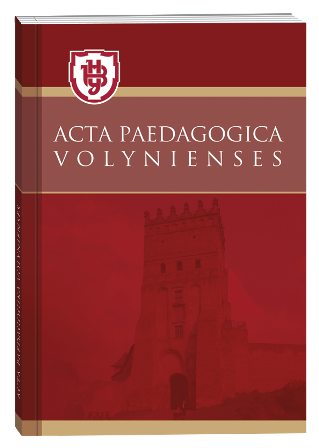FORMATION OF CREATIVE IMAGINATION AMONG APPLICANTS FOR EDUCATION IN THE PROCESS OF LEARNING TO PLAY THE PIANO
DOI:
https://doi.org/10.32782/apv/2022.6.14Keywords:
music lesson, creativity, types of musical activities, information and communication technologies, musical art, culture, general artistic, spiritual development of the individual, means of educationAbstract
The article notes that creative tasks always appear to a person as a task, the method of solving which is unknown to education seekers. It is indicated that as knowledge is gained, wide opportunities for independent search open up. It has been proven that automated skills, generalized concepts, heuristic methods and techniques, and most importantly – an active attitude to knowledge, the most cognitive activity, the dynamics of its motives – the interconnections and development of all these components lead to the formation of a complex process that is the basis of creativity. Considering the concepts of "creative imagination" and "creativity" as subjectively objective phenomena, it can be said that they include both procedural and active components. It is described that the terms "creative activity" and "creative independence" are used in order to mark the active and practical side of creativity, to indicate the need for activity and independence of the subject in the creative process. It has been proven that the creative process is possible and necessary in all areas and spheres of activity and, above all, in art, pedagogical science and practice. It is noted that the operational-creative component is closely connected with the formation of professional skills in education applicants and with the formation of creativity and creative interest in classes. Therefore, teachers should pay attention to the development of musical perception, the formation of proper playing skills in the piano class, it is important to set specific tasks for young pianists, and guide young people to achieve the result. It is noted that the emotional perception of music contributes to better assimilation, the establishment of regular connections between the sounds of the melody, and creates the first vivid images in the mind. Emotional responsiveness is subject to development.
References
Грищенко Т. Зміст і організація форми музично-естетичного виховання в гімназіях України: Перша половина 19 ст. Рідна школа. 2001. № 11. C. 67–69.
Кемеровська О. Мистецтво у розкритті творчого потенціалу дитини. Обдарована особистість: пошук, розвиток, допомога. Київ: Генезис, 2008. С. 150 - 154.
Михайличенко О.В. Загальні методи музичного навчання. Теоретичні питання культури, освіти та виховання: Зб. наук. пр. Вип. 27. Київ: Видав. центр КНЛУ, 2004. С. 49–53.
Печерська Е. Удосконалювати музично-творчий розвиток дітей. Початкова школа. 2000. № 6. C. 15–18
Рева В. Естетичне виховання школярів у процесі сприйняття музики. Мистецтво та освіта. 2009. № 1. C. 4–8.
Рева В. Індивідуальні стратегії формування естетичного сприймання музики школярами. Мистецтво та освіта. 2006. № 1. C. 12–15.
Рудницька О. Мистецтво у контексті розвитку духовної культури особистості. Художня освіта і проблеми виховання молоді. Зб. наук, статей. Київ: Міносвіти України, УЗІМН, 2007. С. 3–11.
Сапожнік О. Музично-естетичне виховання: зміст і структурні компоненти. Рідна школа. 2002. № 12. C. 20–22.
Турчин Т. Естетичне виховання молодших школярів у позакласній роботі. Початкова школа. 2008. № 5. C. 16–17.
Чудак В. Музично-естетичне виховання молодших школярів. Початкове навчання та виховання. 2007. № 16–18. C. 15–20.







